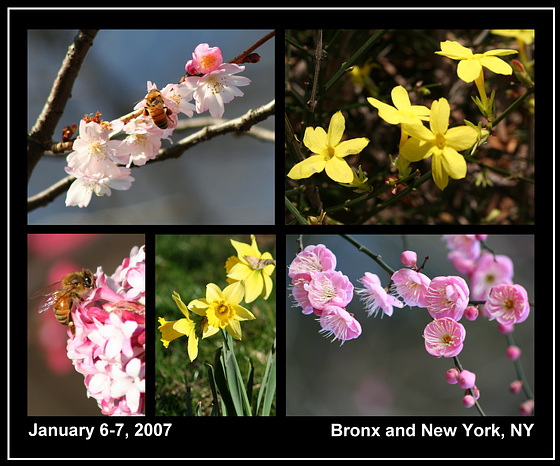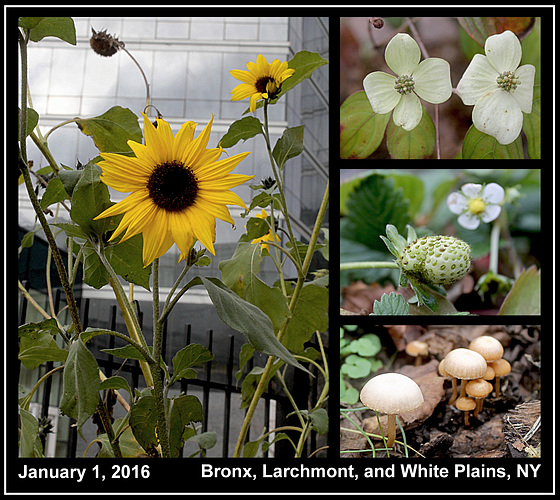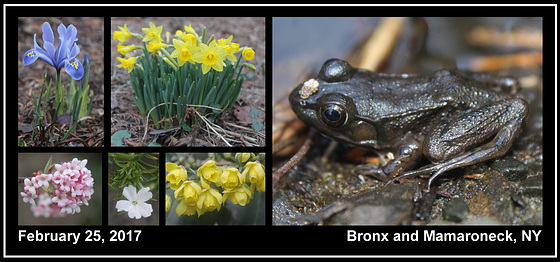Never has good weather felt so bad. Never have flowers inspired so much fear. Never has the warm caress of a sunbeam seemed so ominous. The weather is sublime, it’s glorious, it’s the end of the world. Run for your lives![1]
With temperatures consistently breaking 50º F and 60º F and a peak high of 70º F on the 24th, February 2017 with a mean temperature of 41.6º F set a new record for the warmest February in history in the New York metro area. The previous mark of 40.9º F had been held by February 2012 in the year without a winter in the New York metro area. And with February 2017 being the latest in an accelerating trend of reoccurring anomalous warm winters and/or winter months there may be more truth than one can imagine in the dire warning above.
With its sustained spring-like warmth, people wore shorts and t-shirts, flowers blossomed, vegetables grew, and cold-blooded amphibians such as turtles and frogs emerged from their hibernation, an event that usually occurs in late March or early April for their first documented February appearance.
Although warm, anomalous winters often attributed to blocking patterns and the El Niño phenomenon have occurred in the past in the New York metro area, they are becoming more common with greater extremes in temperature readings – December 2006-January 2007, December 2011-February 2012 (the entire meteorological winter), December 2015 (with an astonishing 50.8º F mean temperature – an incredible 13.3º F above normal – a reading higher than some of the top 10 warmest Novembers!) and now February 2017.
New York metro area winters that used to consist of prolonged, sustained cold interrupted by a few warm days now consist of prolonged, sustained warmth interrupted by a few cold days. Consequently, global climate change appears increasingly responsible with extended growing seasons for crops and flowers alike. Roses often bloom into December, sunflowers have endured into January while some flowering bushes and trees are experiencing two blooms per year while exercising rapid recovery. In addition, the presence of cold-blooded fauna once unheard of during meteorological winter months are becoming more common with shorter hibernation cycles.
Although these winters are infrequent and abnormal, it should be noted the New York metro area has experienced a combination of warm anomalous winters and/or winter months a dozen times since the winter of 1739-40 with 25% having occurred in just the first two decades of the 21st century. These winters and/or winter months with summary diary descriptions, newspaper reports as well as my accounts from December 2006-January 2007 through February 2017 are listed below:
January-February 1740: A summer winter… generally fair and pleasant [with] only two snows, and sledding but about three weeks.[2]
January-February 1751: Pleasant weather… The weather like May (January 21st and 24th)… [T]his winter ends, wonder throughout the whole.[3]
January-February 1773: [W]onderful moderate… weather. There has been no snow, and but little rain since the 29th of December. We saw two robbins (sic). [4]
December 1777: Violets in blossom… a few days after Christmas.[5]
Winter 1824-25: Notably mild.[6]
Winter 1827-28: This winter… is remarkable for its mildness. [N]o snow or frost… [M]ild rains every where instead of snows… the first winter ever known that the (Susquehanna) [R]iver has continued clear of ice![7] The Hudson, with the exception of a few days, was navigated the whole winter… [T]he ground was bare almost the whole winter… The weather was mild with a few exceptions. Some days were warm. Bees came out. Flies appeared. The buds of willows swelled, and vegetation threatened to burst out…[8]
Winter 1931-32: Coatless citizens pluck[ed] pansies and pussy willows… sunbathers basked under the warm sun… [T]ulips, daffodils and hyacinths popped through the earth, roses broke out in a rash of buds and lilac and rhododendron bushes showed Spring-like activity… Magnolias opened… Robins flashed over pansy beds… [S]trawberry plants blossomed… [a White Plains, NY man] chased butterflies in his garden… [and] an audacious grasshopper leaped with joy.[9]
Winter 1949-50: Frogs peeped in [December]… Spring flowers (adonis, azaleas, forsythia, anemones and violets) bloomed… pansies threaten[ed] to run rampant… residents discarded winter overcoats… bluebirds were reported sighted… a groundhog even poked out his head in confusion… It looked and felt like spring![10]
December 2006-January 2007: Cherry blossoms and forsythia burst into bloom. Adonis and daffodils are enticed by spring-like temperatures. Turtles are reported observed in December; bees are present. No measurable snow is recorded until January 8th.
Winter 2011-12: Only one day of accumulating snow. All melted by the next day. Flowers abound in record diversity, and robins and bees are present in abundance every day. Turtles were reported seen in December; chipmunks were photographed in February. There was no winter! Autumn persisted followed by spring!
December 2015: A summer-like month. Summer and autumn flora coexist. A flowery paradise. No freezes. Frogs and turtles photographed through December 27th. Shorts and t-shirts are the apparel of choice. Christmas Day a good day for a swim in the Long Island Sound!
February 2017: Pansies thrive throughout the meteorological winter. An array of flowers burst into bloom; unharvested crops resume growth. Frogs and turtles awake from the comfort of their hibernation. People don summer attire. Robins hop about. Spring is in the air!
Nevertheless, despite their seemingly benign nature, the growing frequency of anomalously warm winters and/or winter months is reason for concern that should not be dampened by the fact the Earth has faced extreme epochal warmth before. Scientists are already warning of a possible impending mass-extinction event, the sixth in the planet’s history in which we may not be immune based on the projected loss of up to 60% of the world’s 504 primate species (our closest relatives)[11] and the falling human fertility rate “with half the world’s population already below the replacement ratio.”[12] It already happened with the Neanderthals Homo neaderthalensis (c. 198,000 BCE-22,500 BCE), a hominid species inhabiting the lands comprising Western Europe to Central Asia that was rendered extinct after their fertility rate plunged and therefore as global warming continues there should be a growing sense of urgency even if a correlation between the decline in primate and human fertility rates and climate change cannot be easily proven and our direct impact remains in dispute. Otherwise, while life may continue beyond the 21st century, it may no longer include Homo sapiens with crumbling buildings, overgrown decaying roads, a dark power grid and an abundance of non-biodegradable garbage and waste, the artifacts of the Anthropocene epoch (c. 1950-present) providing a sad testament of our past existence until everything is overgrown, crumbles and disappears into dust.
___________
[1] Joel Chenbach. March in January! Or isit Mayday? The Washington Post. 7 January 2007. www.washingtonpost.com/wp-dyn/content/article/2007/01/06/AR2007010601215.html?sub=AR
[2] This Winter. The Hartford Courant. 23 January 1932. 10.
[3] This Winter. The Hartford Courant. 23 January 1932. 10.
[4] Warm Winters. The Hartford Courant. 3 February 1838.
[5] This Winter. The Hartford Courant. 23 January 1932. 10.
[6] John Thomas Scharf and Thomas Westcott. History of Philadelphia 1609-1884. L.H. Everts & Co. (Philadelphia. 1884). 1599.
[7] Watson’s Annals of Philadelphia and Pennsylvania. Vol. II, Chapter 14. 1 February 2007. ftp.rootsweb.com/pub/usgenweb/pa/philadelphia/areahistory/watson0212.txt
[8] James Macauley. The Natural, Statistical and Civil History of the State of New York. Vol. I. Gould & Banks. (New York, 1829). 397.
[9] Patrick J. Michaels. What’s So Bad About a Warm Winter? The American Spectator. 19 January 2007. spectator.org/dsp_article.asp?art_id=10897, ‘Spring’ Ending Here: Snow in Los Angeles. The New York Times. 16 January 1932. 17, and Freak Weather Continues Here But Nears End. The Hartford Courant. 16 January 1932. 1 and 4.
[10] Mild Spell Stirs Odd Doings In Plant And Animal World. The Hartford Courant. 28 December 1949. 1, ‘Heat Wave’ Again Sets Record Here. The Hartford Courant. 5 January 1950. 2, January Gets June Weather So Out Come Rocking Chairs. The Hartford Courant. 5 January 1950. 1, and City Swelters at a Record 65.6º; Freeze Due Tomorrow Morning. The New York Times. 5 January 1950. 1.
[11] Ivan Semeniuk. Researchers find three-quarters of the world’s 504 primate species are in decline. The Globe and Mail. 18 January 2017. www.theglobeandmail.com/technology/science/primates-face-mass-extinction-by-mid-century-scientistswarn/article33654822
[12] Max Roser. Global Population Falling As Human Fertility Declines. University of Oxford. 11 July 2016. principia-scientific.org/global-population-falling-as-human-fertility-declines












We now gat winters of a milder type alternating with winterless years, the cold winter years often have extremely hot summuers, the others have 'How should I say ?' Ah yes, Two winters, a wet one and a green wet one.
Global warming will result in flooding causing people to move to higher ground, this can lead to wars thereby reducing the world population slightly.
It is also predicted that the waming will end as a new Ice Age.
Looking at some creatures and plants that managed to survive the most recent true Ice age in Japan where the Ainu folk, The Piping Hare and a very special type of Violet among others.
All of the reliable data, not to mention changing growing seasons, shifting vegetation, and declining Arctic sea ice, reveal ongoing climate change. For perspective, the last below normal month on a global basis was July 1985 (0.01°C below normal) and the last colder than normal year was 1976 (0.12°C below normal) according to the GISS dataset.
Stormlizard club has replied to William Sutherland clubI began reading articles in the British Scientific monthly magazine 'Science Journal' in the late fifties early sixties where warnings of our (Human) stupidity has done so much damave to the Natural environment that we should think seriously about changing our ways such as the Dumping of mixed refuse in old clay pits, titpping the same directly into the sea, pumping untreated sewage into rivers, lakes and the oceans and removing forests totally. Very few listened, Politicians were especially anti clean up. Disused coamines were used for Nuclear waste as was the sea. Many Industrial nations exported their refudse to what were refered to as 'Third wirld nations'.
William Sutherland club has replied to Stormlizard clubStormlizard club has replied to William Sutherland clubI had been trying to put a much less concise piece such as this together. You have done a wonderful job.
I collate weather as you know I think. This is a time a real and valid change. We are not at the balance point.. but the tipping point.
Maybe this is what has to happen.. maybe Nature has to wipe clean the errors... its a very valid point that it is going to happen.
Already the gulf steering current has a temporary stop before resuming. If it stops, they'll be devastating starvation in our countries since it will be come much colder. But as you say, the Earth has to clean away the errors. And most tragic as all, as Primates, our closest relative are disappearing, the Neanderthals vanished, we too with plummeting fertility rates are moving in this same direction. And we don't even notice it and won't even notice when we pass the tipping point either!
Thank you David.
I can only hope we can change our legacy for future generations since it is not good and not just from a climatological standpoint.
Sign-in to write a comment.